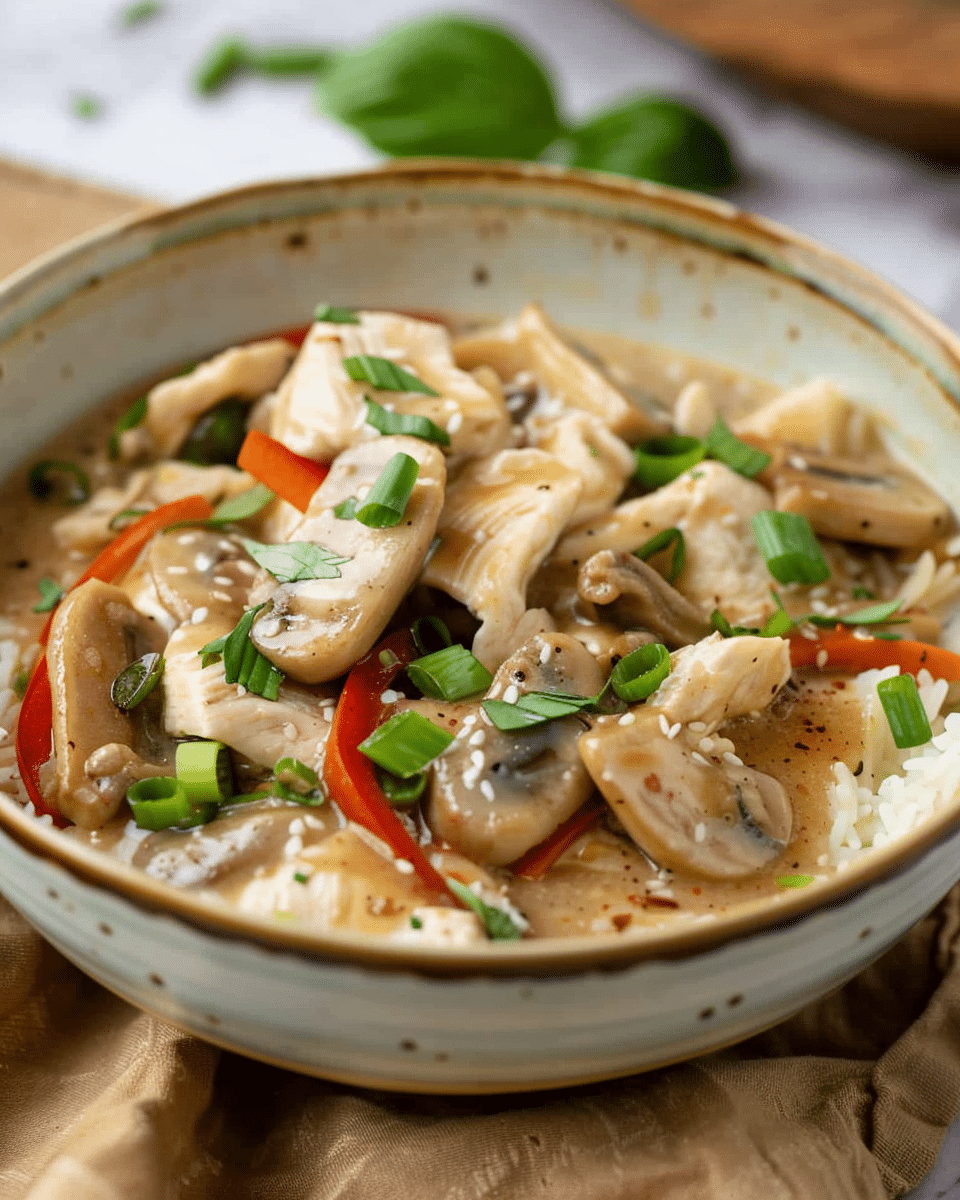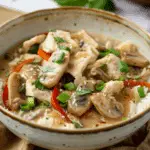Why You’ll Love This Recipe
Moo Goo Gai Pan is a light, healthy, and flavorful stir-fry that comes together in just one pan. The tender chicken is perfectly complemented by an array of vegetables, creating a dish that is not only delicious but also full of nutrients. The sauce is savory without being overly heavy, making it a great choice for anyone looking for a healthier take on traditional Chinese takeout. Plus, it’s naturally gluten-free and can be easily adapted to suit your dietary preferences.
Ingredients
-
1 lb boneless, skinless chicken breasts or thighs, thinly sliced
-
2 tablespoons vegetable oil (or sesame oil)
-
1 onion, thinly sliced
-
2 cloves garlic, minced
-
1 cup mushrooms, sliced (shiitake or white button mushrooms work well)
-
1 cup snow peas, trimmed
-
1 red bell pepper, sliced
-
1/2 cup baby corn, chopped (optional)
-
1 tablespoon fresh ginger, grated
-
1/4 cup low-sodium soy sauce or tamari (for gluten-free option)
-
2 tablespoons chicken broth
-
1 tablespoon oyster sauce (optional, or substitute with extra soy sauce)
-
1 tablespoon cornstarch (for thickening)
-
2 tablespoons water
-
Salt and pepper to taste
-
2 green onions, sliced (for garnish)
(Tip: You’ll find the full list of ingredients and measurements in the recipe card below.)
Directions
-
In a small bowl, whisk together the soy sauce (or tamari), chicken broth, oyster sauce (if using), cornstarch, and water. Set aside.
-
Heat vegetable oil in a large skillet or wok over medium-high heat. Add the sliced chicken and cook for about 5-6 minutes, stirring occasionally, until the chicken is browned and cooked through. Remove the chicken from the skillet and set it aside.
-
In the same skillet, add a bit more oil if necessary and sauté the onion and garlic for 2-3 minutes until fragrant and softened.
-
Add the mushrooms, snow peas, bell pepper, and baby corn to the skillet. Stir-fry for about 4-5 minutes, or until the vegetables are tender-crisp.
-
Add the grated ginger and cook for another minute until fragrant.
-
Return the cooked chicken to the skillet. Pour in the prepared sauce and toss everything to coat evenly. Let the sauce simmer for 2-3 minutes until it thickens.
-
Season with salt and pepper to taste, and garnish with sliced green onions before serving.
Servings and Timing
This recipe serves 4 people. Preparation time is about 10 minutes, and cooking time is approximately 15-20 minutes, making the total time around 30 minutes.
Variations
-
Vegetarian Option: Substitute the chicken with tofu or tempeh for a vegetarian version of Moo Goo Gai Pan.
-
Extra Vegetables: Add extra vegetables like carrots, broccoli, or bok choy for more color and nutrition.
-
Spicy Version: Add a pinch of red pepper flakes or a sliced chili pepper to give the dish a spicy kick.
-
Low-Carb Option: Serve over cauliflower rice instead of traditional rice for a low-carb alternative.
Storage/Reheating
-
Storage: Store leftovers in an airtight container in the refrigerator for up to 3 days.
-
Reheating: Reheat in a skillet over medium heat, adding a splash of water or chicken broth to prevent the dish from drying out. Alternatively, you can microwave it in short intervals, stirring in between.
FAQs
Can I use frozen vegetables in this recipe?
Yes, you can use frozen vegetables, but fresh vegetables will give the dish better texture and flavor. If using frozen, make sure to thaw and drain them before cooking.
Can I use chicken thighs instead of chicken breasts?
Yes, chicken thighs work perfectly in this recipe and will add extra flavor and tenderness. Just make sure to cook them through.
Can I make Moo Goo Gai Pan ahead of time?
While it’s best enjoyed fresh, you can prepare the chicken and sauce ahead of time. Stir-fry the vegetables and assemble everything just before serving.
Is Moo Goo Gai Pan gluten-free?
Yes, if you use tamari instead of soy sauce and make sure that the oyster sauce (if using) is gluten-free, this recipe can be made gluten-free.
How can I make the sauce thicker?
To make the sauce thicker, simply increase the amount of cornstarch or let the sauce simmer for a bit longer to reduce it to your desired consistency.
Can I make Moo Goo Gai Pan spicy?
Yes, add some red pepper flakes, sliced fresh chili peppers, or a dash of hot sauce to the stir-fry to give it a spicy kick.
What can I serve with Moo Goo Gai Pan?
This dish is perfect on its own or served with steamed rice, cauliflower rice, or noodles for a more substantial meal.
Can I freeze Moo Goo Gai Pan?
While it’s best fresh, you can freeze the cooked chicken and vegetables for up to 2 months. The texture of the vegetables may change slightly upon thawing, but the dish will still be delicious.
How do I know when the chicken is fully cooked?
The chicken should be cooked through with no pink remaining in the center. You can check the internal temperature with a meat thermometer, aiming for 165°F (74°C).
How can I make this recipe more flavorful?
You can increase the amount of ginger and garlic, or add a splash of rice vinegar or sesame oil to enhance the flavor profile of the dish.
Conclusion
Moo Goo Gai Pan is a delicious, healthy, and easy-to-make stir-fry that delivers on both flavor and nutrition. The tender chicken, fresh vegetables, and savory sauce create a satisfying meal that’s perfect for busy weeknights or meal prepping. Whether you’re looking for a quick dinner or a dish to impress your guests, Moo Goo Gai Pan offers a fresh take on a Chinese classic. Enjoy it on its own or pair it with your favorite sides for a complete meal.
Moo Goo Gai Pan
5 Stars 4 Stars 3 Stars 2 Stars 1 Star
No reviews
Moo Goo Gai Pan is a classic Chinese-American stir-fry featuring tender chicken, fresh vegetables like mushrooms, snow peas, and bell peppers, all tossed in a savory sauce. This light and healthy dish is quick to make, full of flavor, and perfect for a weeknight dinner.
- Author: Laura
- Prep Time: 10min
- Cook Time: 15min
- Total Time: 30min
- Yield: 4servings
- Category: Main Course
- Method: Stir-fry
- Cuisine: Chinese-American
- Diet: Gluten Free
Ingredients
1 lb boneless, skinless chicken breasts or thighs, thinly sliced
2 tablespoons vegetable oil (or sesame oil)
1 onion, thinly sliced
2 cloves garlic, minced
1 cup mushrooms, sliced (shiitake or white button mushrooms work well)
1 cup snow peas, trimmed
1 red bell pepper, sliced
1/2 cup baby corn, chopped (optional)
1 tablespoon fresh ginger, grated
1/4 cup low-sodium soy sauce or tamari (for gluten-free option)
2 tablespoons chicken broth
1 tablespoon oyster sauce (optional, or substitute with extra soy sauce)
1 tablespoon cornstarch (for thickening)
2 tablespoons water
Salt and pepper to taste
2 green onions, sliced (for garnish)
Instructions
-
Make the Sauce: In a small bowl, whisk together the soy sauce (or tamari), chicken broth, oyster sauce (if using), cornstarch, and water. Set aside.
-
Cook the Chicken: Heat vegetable oil in a large skillet or wok over medium-high heat. Add the sliced chicken and cook for about 5-6 minutes, stirring occasionally, until the chicken is browned and cooked through. Remove the chicken from the skillet and set it aside.
-
Cook the Vegetables: In the same skillet, add a bit more oil if necessary and sauté the onion and garlic for 2-3 minutes until fragrant and softened.
-
Stir-Fry the Vegetables: Add the mushrooms, snow peas, bell pepper, and baby corn to the skillet. Stir-fry for about 4-5 minutes, or until the vegetables are tender-crisp.
-
Add Ginger and Sauce: Add the grated ginger and cook for another minute until fragrant. Return the cooked chicken to the skillet. Pour in the prepared sauce and toss everything to coat evenly. Let the sauce simmer for 2-3 minutes until it thickens.
-
Finish and Serve: Season with salt and pepper to taste, and garnish with sliced green onions before serving.
Notes
-
Vegetarian Option: Substitute the chicken with tofu or tempeh for a vegetarian version of Moo Goo Gai Pan.
-
Extra Veggies: Add extra vegetables like carrots, broccoli, or bok choy for more color and nutrition.
-
Spicy Version: Add a pinch of red pepper flakes or a sliced chili pepper to give the dish a spicy kick.
-
Low-Carb Option: Serve over cauliflower rice instead of traditional rice for a low-carb alternative.



